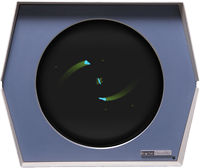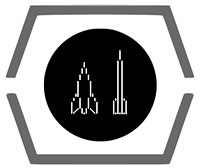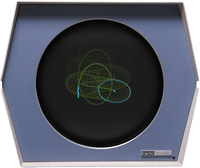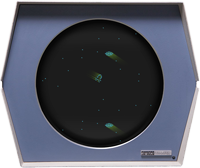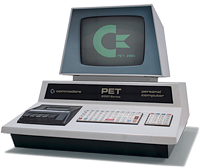Lounge
Mixed content of various nature…
For the very purpose of your esteemed entertainment.
A Tribute to After Dark
The first and only screen-saver on the web.
Perfectly useless, perfectly nice. They are back:
The origiginal Flying Toasters are © 1990 Berkeley Systems Inc.
by Jack Eastman, Bruce Burkhalter, and Patrick Beard,
Artwork by Tomoya Ikeda.
(The real stuff to safe your screen.)
Retro Computing & Computing History
RetroChallenge(s)
“RetroChallenge is a loosely disorganised gathering of RetroComputing enthusiasts who collectively do stuff with old computers for a month. (…) While the RetroChallenge has its competitive side, it’s not really a contest… it’s more like global thermonuclear war — everyone can play, but nobody really wins.”
Part of the fun and challenge is doing both the project and detailled write-ups (AKA, a blog)…
RetroChallenge 2018/04:
“Refraction” for the Atari VCS (Atari 2600)

We're approaching again a device from 1977 and a MOS 6502-type processor, this time, it's about the venerable VCS and racing the beam …
Related, 8-Bit Sounds: Studio2600 for the Atari VCS (Atari 2600)
I just wanted to test sounds, but it became a synthesizer…
(online demo and downloads)
RetroChallenge 2017/04:
Personal Computer Space Transactor 2001
After our success with the PDP-1, we try our luck with the iconic PET 2001 microcomputer (1977) and its MOS 6502 processor, in order to get a comparison …
Includes a detailed description of Computer Space and the workings of early video arcade games.
Related, run a virtual PET 2001 in the browser: www.masswerk.at/pet/.
RetroChallenge 2016/10:
Ironic Computer Space Simulator for the DEC PDP-1
Bringing the first arcade video game from 1971 to the early 1960s machine, which's show case program, Spacewar!, had inspired it in the first place. — PDP-1 assembler code in 2016 …
Run the program on a virtual PDP-1 in the browser: www.masswerk.at/icss/.
RetroChallenge 2016/01:
Maze War for Olivetti M10 and NEC PC-8201A
Networking retro machines, exploring history, experimenting with graphics, implementing a vintage game, BASIC — we do it all in a single project!
DEC PDP-1 & Spacewar!
In 1959 the Digital Equipment Corporation (DEC) introduced a small, fully transistorized mainframe computer, optimized for real-time operations and featuring one of the first commercially available visual displays (based on a CRT tube for scan RADAR equipment). The PDP-1 (Programmed Data Processor 1) was some of a commercial version of the M.I.T.-tradition of interactive computing and so, in 1961, one of the first production models was donated by DEC to M.I.T., where something amazing happened…
Spacewar! – First Digital Video Game (1962)
| Play the original code of “Spacewar!” in your browser! Various versions of the program are available in a carefully crafted emulation (HTML5 & JavaScript), including a recreation of the peculiar CRT display. |
See also an alternate presentation, featuring more detail in a bigger display and more accessible controls. (Note: There's no support for touch devices in this version.)
Spacewar! related resources:
- Spacewar! 4.4 – Spacewar! for two displays (1963)
I unearthed an arcane version of Spacewar!, displaying the game on two displays, one for each player in their very own perspective. Experience orbital mechanics all new, including epicycles! - “The Origin of Spacewar” by J. M. Graetz (redacted and consolidated copy).
The seminal account of Spacewar!, first published in the August 1981 issue of Creative Computing magazine (Volume 7, Number 8). Includes additional text and images. - “Spacewar! – Real-Time Capability of the PDP-1” by J.M. Graetz (Decus Proceedings 1962)
The official paper on Spacewar!, as presented on the first DEC Users Conference (Decus). - A fully restored PDP-1 is on display at the Computer History Museum in Mountain View (CA, USA). The museum doesn't only a demonstration run every two weeks, but also maintains a website dedicated to the PDP-1 Restoration Project.
Inside Spacewar! – A Software Archeological Approach to the First Video Game
| Inside Spacewar! — My own series on Spacewar! research and software archeology, featuring a detailed walk-through and analysis of the original code. So now we know, what is actually inside and how it was done. (Spacewar! features various programming paradigms remarkably early in history, like object oriented approaches or a just-in-time compiler for displaying any of the spaceship outlines from configurable templates.) |
The Minskytron (and other “display hacks”)
| The Minskytron and other so-called “display hacks” are interactive graphics demonstrations done for the PDP-1 in the early 1960s. Now you can run the original programs in emulation in your browser. Includes the Minskytron by Marvin Minksy, Munching Squares by Jackson Wright, and Snowflake from a still unknown author. |
See also for a similar graphics demo: Graphical Fun for the PDP-1 by David Mapes.
Ironic Computer Space Simulator (ICSS)
In 2016 I did my very own program for the PDP-1 – an all new program in PDP-1 assembler code. Amazingly, it runs at 60 frames per second – not that bad for an early 1960s computer!
| Ironic Computer Space Simulator is a simulation of the first video arcade game (Computer Space, 1971) on the early 1960s machine, which inspired it in the first place. Notably, Computer Space was not a program, but rather implemented in hardware using discrete logic chips. See my blog for RetroChallenge 2016/10 for a series of write-ups on the process of implementing the game. |
Commodore PET 2001
The Commodore PET 2001 was one of the “1977 trinity” of early home computers.
PET 2001 Emulation
| Run an emulated Personal Electronic Transactor 2001 in your browser. You may even write BASIC programs or 6502 assembler code in your favorite text editor and run it by simple drag-and-drop. Based on an original emulator by Thomas Skibo. (As any pet should be, it’s friendly to the touch and enjoyable on a couch.) |
See the program library for manuals and some recreational programs to download or to run them directly in the emulator.
There are also various blog articles on the subject of the PET 2001.
Commodore VIC-1001 Kana
The VIC-20, Commodore’s consumer oriented successor to the PET 2001, started as the VIC-1001 in the Japanese market in October 1980. The most prominent distinction from the international markets VIC-20 was the inclusion of a Japanese Katakana character set in the ROM (character-set 2). Find all about the keyboard layout, character glyphs, PETSCII codes, and character ROMs here: Commodore VIC-1001 Kana (Japanese VIC-20 Characters) Demystified.
BASIC, General
QBASIC to BASIC Transformer
The QBASIC to BASIC Transformer is a little tool to transform QBASIC like sources to common BASIC. Supports automatic line numbering, comments with apostrophes (single quotes), and labels and named targets with square brackets ([…]). Agnostic of case and BASIC dialects.
Virtual 6502
The Virtual 6502 Suite is a JavaScript emulation for the MOS 6502/6510 8-bit microprocessor, including assembler, disassembler, and a documentation of the 6502 instruction set.
Atari VCS / Atari 2600
A collection of Atari VCS Tools to facilitate “racing the beam”, comprising an online sprite / player graphics editor, a versatile playfield editor (also online), and the Studio2600 synthesizer for exploring Atari TIA sounds.
Algol 60
Nostalgia for algorithmic days: Algol 60 References, including the Revised Report on the Algorithmic Language Algol 60 (1963), EBNF syntax, and sample programs.
See also: EBNF syntax of SIMULA 67.
Punched Cards
The Virtual Card Read-Punch
The Virtual Card Read-Punch — Punch, Read, Execute Virtual Punch Cards.
Relive the joys of punch card processing! Now you may finally submit or share your code as a card stack again.
Punched Card Typography — IBM 026, 029, 129
How text came onto punch cards: Punched Card Typography Explained.
Reconstructing typography from an amazing piece of technology, the IBM code plate.
Inludes interactive infographics and even editors to make your own character sets.
The Virtual Keypunch
The Virtual Keypunch lets you type and download your personal punch card.
Supports various card stock, the IBM/360 column binary format, and query-parameters for linking to a pre-typed card. (A spin-off from/companion application to Google60, see below.)
The Virtual Card Reader
The Virtual Card Reader provides the means for the reverse process: Scan images of punched cards composed with the Virtual Keypunch back to text. (Supports automatic parsing and linking to enclused URLs or Twitter hanles.)
Punch Card Sampler — What is on my Punch Card?
The Punch Card Sampler is a simple tool for detecting data on a punch card.
Nerdy Reading / Digital Library
A lush source of entertainment, a romance in 10,711 punched cards: Nerdy Reading.
Meanwhile, the digital library is busy populating its catalog of nerdy presentations of famous works of literature…
Web Projects
“The map that made a nation cry” — UX-Experiment
Explore Charles Joseph Minard’s famous map of Napoleon's Retreat From Moscow (The Russian Campaign 1812–1813) as an interactive chart.
E.L.I.Z.A. Talking
Exploring client-side speech I/O: E.L.I.Z.A. Talking.
Joseph Weizenbaum’s famous ELIZA program, combining JavaScript-text-to-speech and HTML5 voice recognition for a little chat.
Google60 – Search Mad Men Style.
The prequel to “Google BBS”: Google60 (mainframe style)
Explore the Gabby Ontology Operated Grader and Linguistical Extrapolator, using virtual punced cards and greenbar printouts. Webby Awards official honoree 2013.
(Sadly, the Google API is now defunced, but you may still experience the operations with cached results.)
Google BBS – What Google would have looked like in the 80s
Google BBS Terminal is a working service after a video by Squirrel-Monkey.com to explore Google like it were the 1980s. Compare “If Google were invented in the 80s” (YouTube).
Webbys official honoree (2013) and Lovie Awards winner (2012, silver).
See also:
- Bing BBS Terminal – What Bing would have looked like in the 80s.
- Google-Asteroids – Arcade Style Search.
Score on your query! Shoot your news! A tribute to the age of video games.
(Again, free web search APIs have been defunced since, but there are cached results available to preserve the experience.)
JavaScript Doing The JavaScript Rap
Celebrating version 1.5 of meSpeak.js: JavaScript Doing The JavaScript Rap
Yet another useless Text-To-Speech-application featuring MC meSpeak.
sights of the next war
When war was made for TV, came in green and blury pixels for low-bandwidth video compression, “sights of the next war” was an art project to “provide the sights in order to skip according realities”. While made in 2002, scenarios and locations are still alarmingly present-day. (Updated in 2013 for modern web video standards. Originally, the handmade films were deliverd using Apple QuickTime video encoding.)
Various
JS/UIX (2003)
JS/UIX is a *NIX-like operating system running in the browser and written entirely in JavaScript. It comprises a virtual machine, shell, virtual file-system, process-management, and brings its own terminal with screen- and keyboard-mapping. JS/UIX has been one of the first complex JavaScript-only applications.
BTW, if you enjoy terminal sessions, you may also enjoy this text adventure version of Pac-Man (2006): P.M.D. – The Pac-Man Dungeons. :-)
Mandelbrot Set Exploration
A Simple Mandelbrot Set renderer to explore the wonders of fractal geometry.
Understanding Probability
A few resources related to common misconceptions:
- Probability and Intuition – The Monty-Hall-Problem in Figures
Doors, cars and goats explained, including a simulation run to demonstrate statistics. - A Random Distribution of Wealth
What happens, if 100 persons in a room are given $100 each and give away a Dollar to one randomly chosen person in this room each tick of the clock? How is wealth distributed over time by pure chance? See this series of visual simulations for answers. (Pages & models: 1, 2, 3, 4)
Ludwig Wittgenstein’s “Tractatus logico-philosophicus”
A now rather dated reading machine to explore Wittgenstein’s Tractatus logico-philosophicus (or TLP for short). German text version.
URN:RL – Time for a Proposal (2011)
urn:rl – A Proposal for Real Life Locators,
including an extension “urn:rlt” for time-stamped real life locators as in
<urn:rlt:norbert.landsteiner@at/vienna/1080/lerchenfelder+strasse/66-68/2/39(2011-08-16/19:30/MET)>.
Spacewar! Fleet Action
Spacewar! Fleet Action is a game based on my JavaScript port of the original 1962 Spacewar! and inspired by a quote by Steve Russell. Instead of a single ship, each player commands an entire fleet, or tries to do so, at least.
Error pages
Our error pages enjoy some recognition. Please mind that this is not the version that became first widely known, compare here and here. (Turned out, the characters of Space Invaders are registered trademarks by Taito. However, this could have accounted to fair use, as well, as it certainly did meet the common definition.)
Links
Some unrelated links to public resources:
- Netscape before Netscape (online even after Netscape): Mosaic Communications Corporation.
- Retro Computing Forum.
(Note on the image [on top] and usage: Objet trouvé, a photo found on a flyer for a late 1990s garage club in Vienna. I’ve always liked it for its exceedingly nondescript quality. No rights claimed.)
